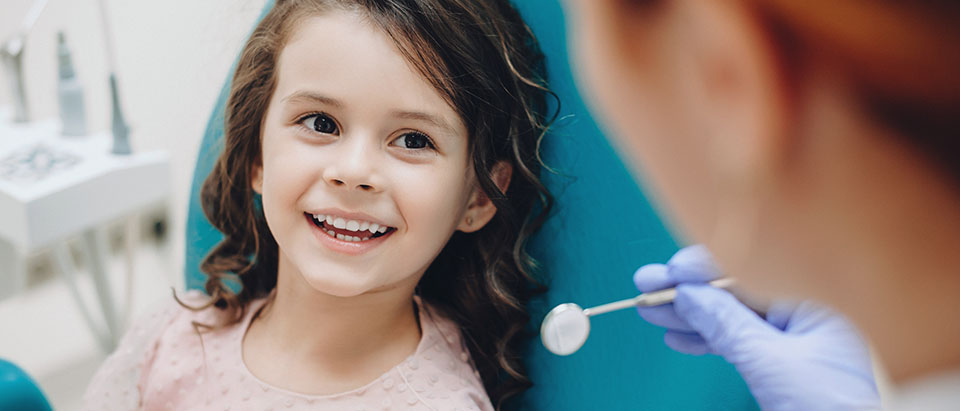
The philosophy of our Grand Rapids orthodontists at Armbrecht & Wierenga Orthodontics is to treat patients at the ideal age in order to eliminate unnecessary work, extractions, and unneeded surgery. We also strive to address potential growth and development issues that may be present at a younger age.
>>> Click here to see our orthodontists be ranked in the top #10 for Grand Rapids!
We have both patients who start treatment as early as 7 years of age and also those who don’t choose to pursue treatment until well into adulthood. Every person is different, and there really is no rule that all the permanent teeth should be in before a patient should have orthodontics.
In fact, sometimes waiting on all of the permanent teeth to come in can actually cause major problems to develop.
Here’s what there is to know about orthodontic treatment for those aged 6 to 11.
Does My Child Need Early Orthodontic Intervention?
Since the 1990’s, the has recommended orthodontic evaluations for children at 7 years old, when most are losing baby teeth and their permanent teeth are emerging.
These early evaluations allow orthodontists, like ours, to recognize irregularities in your child’s mouth before they become major orthodontic issues. After the age of 8, it’s possible that we might miss a window of orthodontic-troubleshooting opportunity.
At both our Grand Rapids and Grandville offices, we offer a free orthodontic screening for any child. We want families to have free access to a trained orthodontic specialist, and the peace of mind that comes along with knowing your child’s jaw and tooth development is on track. Free visits like these also allow families to have accurate, up to date information about their children's jaw and tooth development.
If early orthodontic treatment is deemed necessary, our orthodontists can begin to design a treatment plan to help guide your child’s teeth to their correct positions. At this point, your child will enter what is called .

Phase 1 Orthodontic Treatment
Phase 1 orthodontic treatment is also known as early orthodontic treatment or interceptive orthodontics. Early orthodontic treatment is often started because certain irregularities like crowded teeth are easier to treat in a younger child versus one that is older or an adult because the smaller child’s jaws are still growing.
For instance, with phase 1 orthodontic treatment, our orthodontists may use a palatal expander to expand the upper arch of your child’s teeth, making more room for the permanent teeth to come in less crowded, and potentially more evenly spaced.
If your child didn’t have an orthodontic evaluation until all permanent teeth had emerged, they might need teeth pulled to alleviate the crowding or more extensive straightening to even the spacing between teeth.
Early treatment can also:
- Reduce the need for future tooth extraction or jaw surgery
- Correct how the upper and lower jaw come together (i.e., fix underbites, overbites, open bites, etc.)
- Address a patient’s thumb sucking habit or abnormal swallowing
- Develop healthy, open nasal airways
- Prevent future instances of dental trauma to protruding teeth
- Ensure there is enough room for permanent teeth to avoid overcrowding
- Lessen overall treatment time with braces
Many children don’t need early orthodontic treatment at the time of their initial evaluation. However, this evaluation can still be valuable, because from there we can schedule periodic growth and guidance appointments to monitor your child’s teeth as they emerge and then begin treatment later if it becomes necessary.
The Orthodontic Resting Period
Between Phase 1 and Phase 2 orthodontic treatment will be a “resting period.” During this time, your child’s mouth is allowed to develop on its own and the remainder of your child’s permanent teeth will emerge, most likely in better positions than they would have without intervention.
During the resting period, appointments with our orthodontists may still be scheduled just to monitor the growth and development of your child’s smile. Our orthodontists may also prescribe a custom retainer for your child to wear during the resting period to maintain the effects of Phase 1 treatment.

Why Two Phase Orthodontic Treatment Is Worth It
Although two phases of orthodontic treatment may sound like it will cost more and be more involved, that is not necessarily the case. What we are essentially doing is splitting treatment into two shorter phases of treatment, and the cost of treatment is also split up accordingly. As we have discussed, early treatment can help guide your child’s permanent teeth to emerge in a more favorable position than they were going to naturally.
This can actually save your family time and money by correcting issues before they arise or worsen, thus simplifying orthodontic treatment later in life or in a few cases eliminating the need for it altogether.
Your Child’s First Visit to the Orthodontist
Visiting the orthodontist probably isn’t your child’s idea of a fun outing, but that doesn’t mean it has to be scary! Our staff works with children of all ages every day, and we do everything we can to make their time in the orthodontic chair as comfortable and engaging as possible. We will let you and your child know what we’re doing as we go, and if orthodontic issues are diagnosed, we will help both of you understand the treatment plan we prescribe.
If your child is around the age of 7, and especially if you’re already noticing spacing problems or issues with your child’s bite or jaw, we encourage you to schedule an evaluation with us today to determine if early orthodontic treatment might be beneficial.
Make an Appointment
Contact Armbrecht & Wierenga Orthodontics today at (616) 455-4800 for a complimentary initial consultation with our orthodontists in Grand Rapids, MI, to see if your child could benefit from a first phase of treatment.


